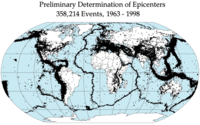
Photo from wikipedia
The investigation of short-term earthquake-clustering features is made feasible through the application of a purely stochastic Epidemic-Type Aftershock Sequence (ETAS) model. The learning period that is used for the estimation… Click to show full abstract
The investigation of short-term earthquake-clustering features is made feasible through the application of a purely stochastic Epidemic-Type Aftershock Sequence (ETAS) model. The learning period that is used for the estimation of the parameters is composed by earthquakes with M ≥ 2.6 that occurred between January 2008 and May 2017. The model predictability is retrospectively examined for the 12 June 2017 Lesvos earthquake (Mw6.4) and the subsequent events. The construction of time-dependent seismicity maps and comparison between the observed and expected earthquake number are performed in order to temporally and spatially test the evolution of the sequence, respectively. The generation of 127 target events with M ≥ 3.0 in the period June–July 2017, just before the main shock occurrence, is examined in a quantitative evaluation. The statistical criteria used for assessing the model performance are the Relative Operating Characteristic Diagram, the R-score, and the probability gain. Reliable forecasts are provided through the epidemic model testifying its superiority towards a time-invariant Poisson model.
Journal Title: Axioms
Year Published: 2022
Link to full text (if available)
Share on Social Media: Sign Up to like & get
recommendations!